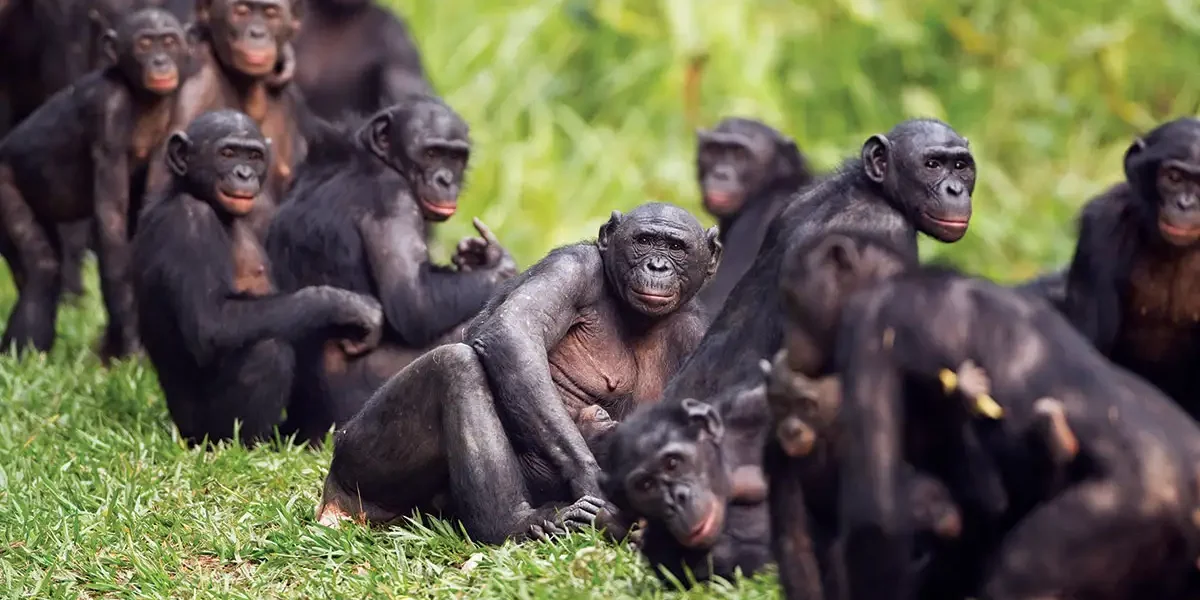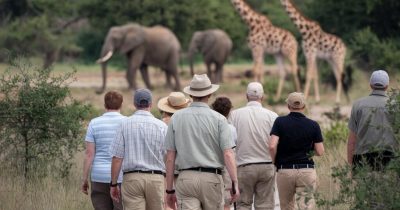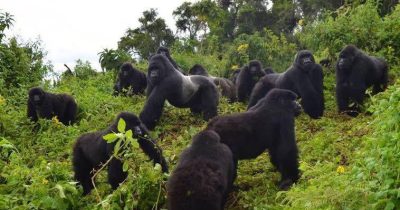Where to See Bonobos in Africa?
Bonobos are one of the large endemic primates living in the forested areas of Africa. They are also called the pygmy chimpanzee and weigh 30-60 kilograms for males and females 30 kilograms. These primate species distinguish themselves from other primates like the chimpanzee. The distinguishing characteristics include relatively long limbs, darker faces, long hair on their bodies, and many others.
Additionally, bonobos share over 98.7% of our DNA with man and are one of the social primates living in a large community of over 120 species. They also live in subgroups of 2 to 15 members, usually based on the females and their offspring. The other large subgroups live near the food sources. More so, female bonobos are usually mature at the age at the age of 12 and are usually ready for mating. Their gestation period goes for up to 8 months. Bonobos usually care for their offspring for about 4 to 5 years and the females for about 5 to 6 years of their lifetime.

Furthermore, bonobos’ life span is unknown and in Africa, they live in the forested areas of the Democratic Republic of Congo. They are usually seen along the Zaire River, Lomami River, Kasai/Sankuru River, and the Lac Ndombe region.
Compare gorillas and Bonobos in Africa
Gorillas and Bonobos are both great apes found in Africa, but they are distinct species with unique characteristics and behaviors.
Key differences between gorillas and Bonobos
Species: Gorillas belong to the genus Gorilla and are divided into two species: the Eastern Gorilla (Gorilla beringei) and the Western Gorilla (Gorilla gorilla). On the other hand, bonobos belong to the genus Pan and are scientifically known as Pan paniscus.
Physical Characteristics: Gorillas are robust and predominantly terrestrial apes with broad chests and large, muscular bodies. They have a pronounced sagittal crest on their heads. On the other hand, bonobos are smaller and more gracile compared to gorillas. They have slender bodies, longer limbs, and a more upright posture.
Habitat: Gorillas inhabit the forests of Central Africa, including countries like Rwanda, Uganda, and the Democratic Republic of the Congo. On the hand, bonobos are found in the dense rainforests of the Democratic Republic of the Congo (DRC).

Social Structure: Gorillas live in cohesive family groups led by a dominant silverback male. The group includes females, juveniles, and infants. On the other hand, bonobos live in complex, egalitarian societies characterized by female dominance and strong social bonds. They are known for their peaceful and cooperative interactions.
Behavior: Gorillas are known for their calm demeanor and gentle nature. They are primarily herbivorous, feeding on leaves, stems, fruits, and occasionally insects. On the other hand, bonobos are highly social and exhibit behaviors such as frequent grooming, playful interactions, and resolving conflicts through sexual behavior. They are omnivorous, consuming a diet that includes fruits, vegetation, insects, and occasionally small mammals.
Distinguishing Features between gorillas and bonobos in Africa
Behavioral Contrasts: While both gorillas and Bonobos are intelligent and social animals, Bonobos are known for their more playful and cooperative behaviors, whereas gorillas tend to have a more hierarchical social structure.
Physical Differences: Gorillas are larger and more robust, with distinctive physical features like the sagittal crest, while Bonobos are smaller and more gracile.
Habitat: Gorillas are found in a broader range of habitats, including mountain forests and lowland jungles, while Bonobos are primarily confined to the dense rainforests of the DRC.
In summary, gorillas and Bonobos are distinct species of African apes, each with its unique characteristics, behaviors, and habitats. While they share common ancestry and belong to the same family of great apes, their differences in physical appearance, social structure, and behavior set them apart in the diverse tapestry of African wildlife.
A Safari Package to see Bonobos in Africa
Bonobos are found in the rain forests of the Democratic Republic of Congo and travelers can take over 8 days to see the bonobos. The safari highlights include;
- Day 1: Arrival in Kinshasa
- Day 2: Kinshasa city tour
- Day 3: Transfer to Menko.
- Day 4: Transfer to Tshumbiri and Nkala
- Day 5: Trekking bonobos
- Day 6: Cultural tour of the Teke people
- Day 7: Transfer from Tsumbiri to Kinshasa
- Day 8: Transfer to the N’djili International Airport
Day 1: Arrival in Kinshasa
Upon arrival in Kinshasa at the Ngobila Airport, you will meet your guide-driver who will transfer you from the airport to the hotel within the Kinshasa city for your dinner and overnight.
Day 2: Kinshasa city tour
On this day, you will start over with an early morning breakfast and then you will start over with the transfer into the city. While in the city, you will engage in the history and culture of the country with your guide. You will also engage in the local vibrant markets. The other destinations that will be visited include; the Kinshasa National Museum, Kabila’s mausoleum, the river Congo banks, and many others
Day 3: Transfer to Menko
After your early morning breakfast, transfer from Menko. During the transfer, you will move from Ngafura Port within Mukulu which is one of the towns in Kinshasa to Tshumbiri. In this transfer which will last for over 2 days, you will engage in the traffic on the river Congo, engage with the local fishermen, and then you will be transferred to Menko village for dinner and overnight.

Day 4: Transfer to Tshumbiri and Nkala
On this day after your breakfast, you will go ahead on the safari to Tshumbiri. Then on arrival in Tshumbiri at around 1500 hours. You will leave the boat and then get on the road to Nkala where you will arrive at around at around 1800 hours. You will camp near the forests.
Day 5: Trekking bonobos
You start your day with an early morning at 0500hrs, you will get into the jungle in search of the bonobos. Then you will have your breakfast along the trek. As you trek through the forests to find the bonobos and will take some time. You will return to the village at around 1200 hours. Then after having your lunch, you will immerse into the community visit of the Teke chiefdom. While in the village, you will meet the Teke people. Later on, you will go ahead with the transfer to the camp for an overnight and dinner.
Day 6: Cultural tour of the Teke people
During this day, you will get back to the Teke people you will have a full-day encounter with them. After you will be transferred to the Tshumbiri for your overnight.
Day 7: Transfer from Tsumbiri to Kinshasa
You will board a vessel which will transfer you back to Kinshasa. During the cruise on the river Congo, you will have your breakfast alone. You will reach Makulu at around 1630 hours. Then later you will have a relaxed evening with Kinshasha.
Day 8: Transfer to the N’djili International Airport
On this last day, you will start the day with the morning breakfast. Then the driver guide will transfer you to the N’djili International Airport for your outbound flights.
What is the best time to see bonobos in Africa?
The seeing of the bonobos in Africa is available throughout the year. During the dry season June to August and December to February. This is the best time to see the bonobos in Africa since the area is more clear for the viewing of these primates.
What should I pack on a safari to see bonobos in Africa?
When preparing to see Bonobos in Africa, particularly in the Democratic Republic of the Congo where they are primarily found, it is essential to pack appropriately for an adventure in the jungle. Here is a comprehensive packing list to ensure you are well-equipped for this unique wildlife experience:
-
- Lightweight, breathable long-sleeved shirts and pants to protect against insects and vegetation.
- Comfortable hiking boots or sturdy walking shoes for jungle terrain.
- Rain jacket or poncho for unpredictable weather conditions.
- Hat and sunglasses for sun protection.
- Swimsuit if your itinerary includes swimming or water activities.
- Binoculars for better wildlife viewing.
- Camera or smartphone with a good zoom lens for capturing wildlife encounters.
- Portable power bank to keep your devices charged.
- Headlamp or flashlight for nighttime activities or walks.
- Insect repellent containing DEET to prevent mosquito bites.
- Sunscreen with a high SPF.
- First aid kit containing essential medications, bandages, and antiseptic wipes.
- Prescription medications, if needed.
- Water purification tablets or a filtered water bottle for safe drinking water.
- Lightweight daypack to carry essentials during excursions.
- Travel guidebook or information about Bonobos and the region.
- Travel documents, including passport, visa (if required), and copies of important documents.
- Cash in local currency for small purchases or tips.
- Travel insurance for medical emergencies
- Field guidebook on African wildlife for identification.
- Binocular harness or strap for easy carrying.
In conclusion, if are planning a trip to see either bonobos or gorillas in Africa, it is essential to travel with a reputable tour operator. That is why Native Africa Tours has a team ready to tailor your safari to make your dreams come true. Talk to us now and create a signature of memories as you learn about these great apes of Africa.













